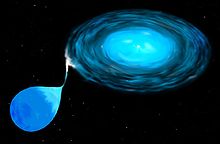Cataclysmic variable star

Cataclysmic variable stars (CV) are stars which irregularly increase in brightness by a large factor, then drop back down to a quiescent state. They were initially called novae, from the Latin 'new', since ones with an outburst brightness visible to the naked eye and a quiescent brightness invisible appeared as new stars in the sky.
They consist of two component stars; a white dwarf primary, and a mass transferring secondary. The stars are so close to each other that the gravity of the white dwarf distorts the secondary, and the white dwarf accretes matter from the companion. Therefore, the secondary is often referred to as the donor star. The infalling matter, which is usually rich in hydrogen, forms in most cases an accretion disc around the white dwarf. Strong UV and X-ray emission is often seen from the accretion disc. The accretion disk may be prone to an instability leading to dwarf nova outbursts, when a portion of the disk material falls onto the white dwarf; these cataclysmic outbursts occur when the density and temperature at the bottom of the accumulated hydrogen layer rise high enough to ignite nuclear fusion reactions, which rapidly convert the hydrogen layer to helium.
If the accretion process continues long enough to bring the white dwarf close to the Chandrasekhar limit, the increasing interior density can ignite runaway carbon fusion and trigger a Type Ia supernova explosion, which completely destroys the white dwarf.
Classification
Cataclysmic variables are subdivided into several smaller groups, often named after a bright prototype star characteristic of the class. In some cases the magnetic field of the white dwarf is strong enough to disrupt the inner accretion disk or even prevent disk formation altogether. Magnetic systems often show strong and variable polarization in their optical light, and are therefore sometimes called polars; these often exhibit small-amplitude brightness fluctuations at what is presumed to be the period of rotation of the white dwarf.
| (Classical) novae | These cataclysmic variables have very large outbursts, of 6 to 19 magnitudes, caused by thermonuclear fusion of material accreted onto the white dwarf. | ||||||
| Recurrent novae | These have outbursts of about 4 to 9 magnitudes, repeating every 10 to 80 years.[1] Examples include T Pyxidis and RS Ophiuchi. | ||||||
| Dwarf novae | Dwarf novae, or U Geminorum stars, are cataclysmic variables which are observed to brighten repeatedly, though by a smaller amount than classical novae.
| ||||||
| Polars |
| ||||||
| VY Sculptoris | These are stars which occasionally drop in brightness by more than one magnitude, with very occasional dwarf-nova-type outbursts during the dim state. They may be a subclass of polars.[2] | ||||||
| AM Canum Venaticorum | These are cataclysmic variables both of whose components are white dwarfs; the accretion disc is composed primarily of helium, and they are of interest as sources of gravitational waves. | ||||||
| SW Sextantis | These are like dwarf novae but have the accretion disc in a steady state, so do not show outbursts; the disc emits non-uniformly. They are usually also eclipsing variables, though this appears to be a selection artefact.[3] |
There are over 1600 known CV systems.[4] The catalog was frozen as of 1 February 2006 though more are discovered each year.
Discovery
Cataclysmic variables are among the classes of astronomical objects most commonly found by amateurs, since a cataclysmic variable in outburst is bright enough to be detectable with very modest instruments, and the only celestial objects easily confused with them are bright asteroids whose movement from night to night is clear.
Around six novae are discovered each year, whilst models based on observations in other galaxies suggest that the rate of occurrence ought to be between 20 and 50;[5] this discrepancy is due partly to obscuration by interstellar dust, and partly to a lack of observers in the southern hemisphere and to the difficulties of observing while the Sun is up and at Full Moon.
Verifying that an object is a cataclysmic variable is also fairly straightforward: they are usually quite blue objects, they exhibit rapid and strong variability, and they tend to have peculiar emission lines. They emit in the ultraviolet and X-ray ranges; they are expected also to emit gamma rays, from annihilation of positrons from proton-rich nuclei produced in the fusion explosion, but this has not yet been detected. [6]
References
- ^ Mobberley, Martin (2009). Cataclysmic Cosmic Events and How to Observe Them. New York: Springer. p. 59. ISBN 978-0-387-79945-2.
- ^ Hameury, Jean-Marie; Lasota, Jean-Pierre (October 4, 2002). "VY Sculptoris stars as magnetic CVs". Astronomy and Astrophysics. 394 (1): 231–239. arXiv:astro-ph/0207084. Bibcode:2002A&A...394..231H. doi:10.1051/0004-6361:20021136.
- ^ "Defining Characteristics of the SW Sextantis Stars".
- ^ Downes, Ronald. "A Catalog and Atlas of Cataclysmic Variables".
{{cite web}}: Unknown parameter|coauthors=ignored (|author=suggested) (help) - ^ Darnley, M. J.; Bode, M. F.; Kerins, E.; Newsam, A. M.; An, J.; Baillon, P.; Belokurov, V.; Calchi Novati, S.; Carr, B. J.; Creze, M.; Evans, N. W.; Giraud-Heraud, Y.; Gould, A.; Hewett, P.; Jetzer, Ph.; Kaplan, J.; Paulin-Henriksson, S.; Smartt, S. J.; Tsapras, Y.; Weston, M. (2005). "Classical novae from the POINT-AGAPE microlensing survey of M31 -- II. Rate and statistical characteristics of the nova population". Monthly Notices of the Royal Astronomical Society. 369: 257–271. arXiv:astro-ph/0509493. Bibcode:2006MNRAS.369..257D. doi:10.1111/j.1365-2966.2006.10297.x.
- ^ Senziani, F; Skinner, G.K.; Jean, P.; Hernanz, M. (2008). "Detectability of gamma-ray emission from classical novae with Swift/BAT". Astronomy and Astrophysics. 485: 223. arXiv:0804.4791. Bibcode:2008A&A...485..223S. doi:10.1051/0004-6361:200809863.
External links
- The Catalog and Atlas of Cataclysmic Variables
- TPP/CVcat - a catalogue of Cataclysmic Variable Stars
- RKcat (Ritter and Kolb), 7th edition
- CVNet, a web site and community for CV enthusiasts and researchers - features announcements of new discoveries
- A Beginner's Guide to Cataclysmic Variables - features a very good categorisation of the different classes of stars
- Cataclysmic Variables, NASA's HEASARC page
